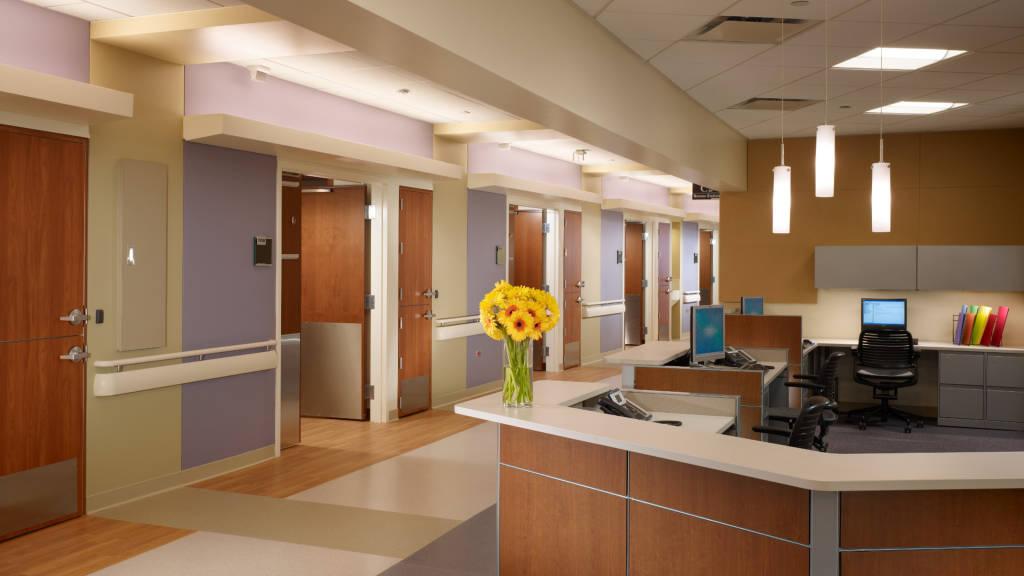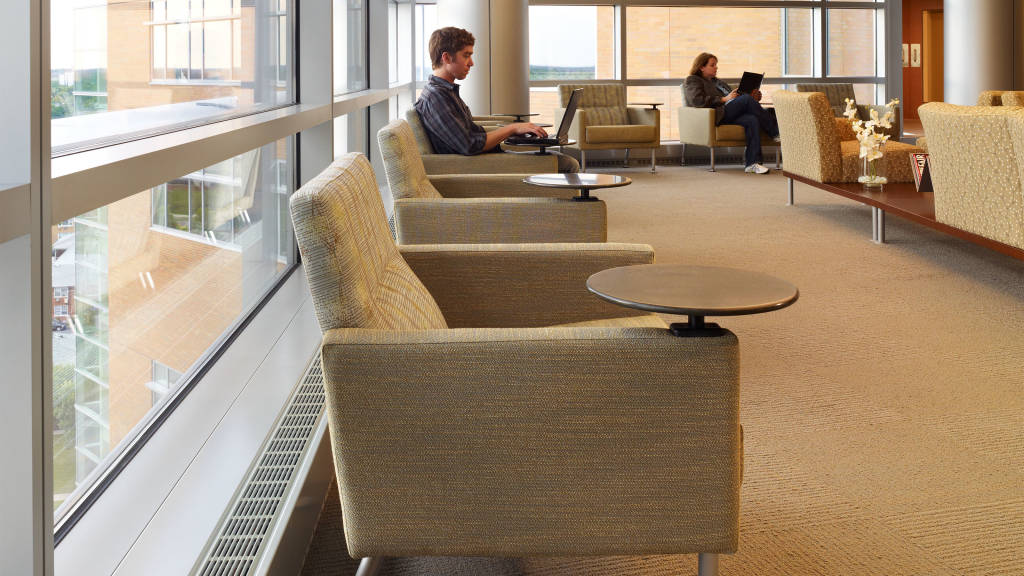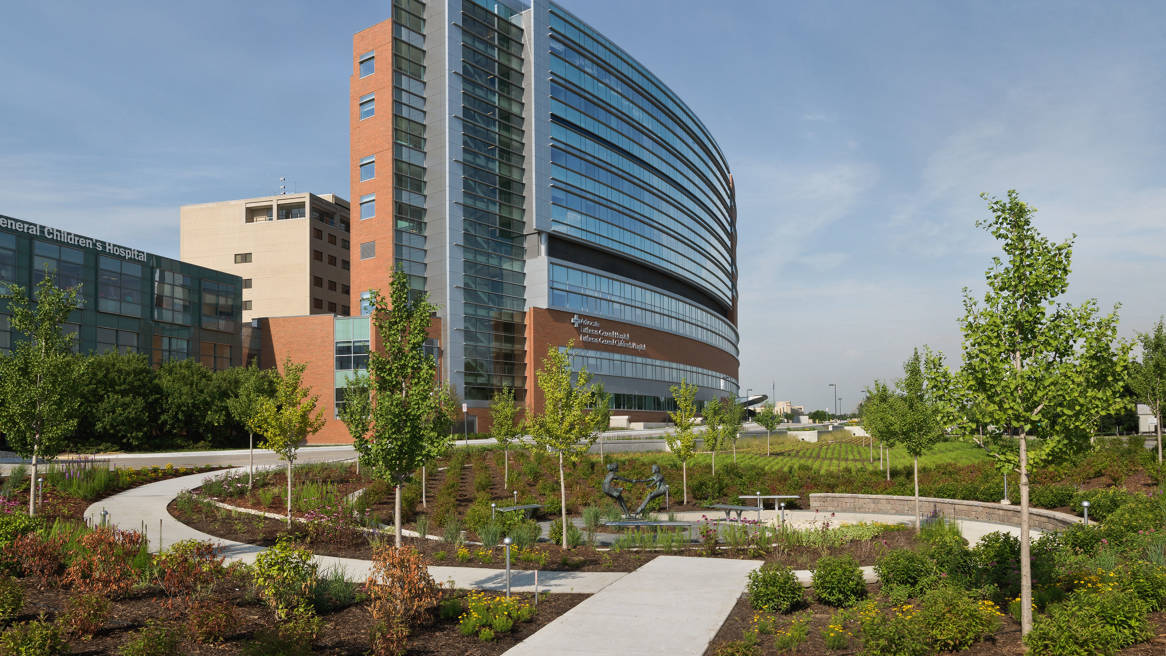Advocate Lutheran General Hospital Redesign
With a project budget of approximately $200 million, Advocate Lutheran General, already a U.S. News and World Report “Top 50” hospital, was ready to re-evaluate how they delivered its patient care, focusing on developing a patient- centered, private room model with a sustainable structure.
Advocate Lutheran General Hospital earns Midwest’s First LEED Gold Certificate raising green standards in a patient-focused environment
Overview
Advocate Lutheran General Hospital (ALGH) is a 645-bed tertiary, quaternary care, academic and research hospital, a Level 1 trauma center, and one of the largest hospitals in the Chicago area. A number of years ago, Advocate Lutheran leadership (ALGH) began to envision a bold, new replacement tower for its aging, existing patient structure.
With a project budget of approximately $200 million, Advocate Lutheran General, already a U.S. News and World Report “Top 50” hospital, was ready to re-evaluate how they delivered its patient care, focusing on developing a patient- centered, private room model with a sustainable structure.
ALGH set clear goals for an operationally efficient building to meet patients’ needs now and well into the future. The leadership team embraced a high-level of community and environmental responsibility and directed the design team to not only pursue LEED (Leadership in Energy and Environmental Design) Gold Certification, but to use the project to help facilitate change throughout the organization – in operations, finance, and community relations – change that only major construction can achieve.
The architects on the project were Chicago-based, OWPP / Cannon Design. In addition to the LEED goal – patient safety, floor plan efficiency and improved quality-of-life for patients and caregivers drove the design.
Steelcase Health and Chicago area dealer, Office Concepts Inc., worked closely with OWPP / Cannon Design from the outset of the project, to advise on products and provide research- based insights that would support the ALGH goals. “This was a truly in-depth and detailed collaborative effort by everyone involved, said Margaret Cervantes, of OWPP / Cannon.
“The work and cooperation between our team, the hospital leadership and clinical staff, the contractor, Steelcase Health and their dealer, Office Concepts, was outstanding and it truly shows in the end result.”
Patient Centered Design = Patient Centered Care
OWPP / Cannon Design worked diligently to design a new patient care tower that improves the environment for patients, their families and staff. Here are just some of the features that OWPP / Cannon Design worked into the space that makes the new ALGH patient tower a very special facility.
Patient Room of the Future
The tower features large, private rooms – each with the same layout. This “same-handed” approach provides staff easy orientation and consistency for procedures, improving safety and helping caregivers respond to patient needs quickly.
Each room has hand washing stations just inside the entrance, to help reduce infections and nurse servers that open both inside and outside of the room to provide ready access to supplies.
Patient amenities abound as well – flat screen televisions, internet access, easily accessible temperature and lighting controls, a personal safe and storage space and large windows with privacy and room darkening options.
Each space also contains a dedicated family zone, with a table, chair, recliner and sofa to provide sleeping accommodations for loved ones. Family centered care is key to the design. “ALGH was passionate about this aspect of the project, says Cervantes. “Their old space did not support families well and that component has become a central part of their focus on holistic care.”
Steelcase Health’s Sieste family of sofa sleepers and recliners used in every patient room. For staff comfort and convenience – Steelcase Health’s Verge stools are also in each room – enabling ease of charting and for use in patient and family consultation.
There’s also a Family Care Center on the first floor with eight, private furnished rooms to provide a quiet space for loved ones in surgery or intensive care.
Modular Nursing Stations and a Flexible, Open Floorplan
Inpatient floors have been laid out in virtual “pods” using a universal floor plate design that can easily be converted based on future demand. Each pod has a decentralized nursing station to decrease noise levels and travel distances, with a column-free interior to allow better sight lines of care and flexibility for future growth in the core areas.
“We spent more than two years doing mock-ups to get to the optimal design,” said Cervantes. “We worked with Steelcase Health to mock up all of the furniture – recliners, sleep sofas and especially the various nurses’ stations.”
“We carefully evaluated everything — from supporting staff processes, staff interaction and supporting technology and power needs to show what the end product would be and that it would allow us the flexibility needed to support all of those components moving into the future.”

Steelcase’s Montage was used for nursing stations – because of its modularity and its ability to be tailored to economically match with specific functions that the nurses needs. Montage has the ability to change panel heights and widths and change materials on frame tiles while maintaining a crisp overall aesthetic.
With Montage’s ability to handle power and data cables, equipment requirements and easy access to data cables, it was an easy choice.
Nursing stations also feature Steelcase Cachet chairs – constructed of more than 98% recyclable content. The Cachet chair is exceptionally durable and easy to clean, for a longer life and has both Indoor Advantage™ certification for indoor air quality and level™ 1 certification. More about Cachet’s environmental profile can be found here.
Special Places
A stunning public lobby/reception area welcomes visitors with a sculpture featuring 150 doves and a two-story interactive Living Light Wall. There is also a beautiful courtyard “meditation” garden and rooftop terrace with dog and cat shaped chairs for children.
“The use of stone, natural wood and decorative glass with plant features bring the restful, healing look of nature to the lobby and throughout the entire building,” said Cervantes. Coalese’s Passerelle and Sidewalk lounge products were used to create a comfortable, contemporary feel in the lobby. Steelcase Architectural Walls were used to create admitting and finance offices in the lobby.

Steelcase Think chairs were used in many of the administrative offices. The Think chair is the first product to ever receive Cradle to Cradle™ Product Certification from McDonough Braungart Design Chemistry (MBDC) and has Gold-level certification. The Think chair is also more than 98% recyclable by weight. More about Think’s environmental impact can be found in here.
Green Gallery
Just off the main lobby, ALGH created an interactive, educational space to help educate the public about what they did with the development of this project and the organization’s commitment to green projects moving forward.
Lessons in LEED
The project was officially certified as a LEED Gold environ- ment in July of this year. Some “green” lessons learned by the project team are detailed by OWPP / Cannon Design in the four key recommendations below:
Invest in Energy
Buildings are responsible for nearly half of all greenhouse gases, and hospitals are the third largest energy-using building type (behind research labs and food service) at 250BTU’s/SF per user on average. Hospitals utilize 50% more energy than a typical office building per square foot. A recent report from the Department of Energy indicates that the average hospital spends 15% of its’ revenues on energy.
Because the ALGH project replaced central plant equipment, large reductions were possible by selecting highly efficient components.
Most of the additional cost was offset by pre-purchasing major equipment such as boilers, chillers and air handling units. The design team performed a life-cycle cost analysis that allowed ALGH to make decisions on how they wanted to balance first cost and energy savings. They then pre- purchased the equipment directly, locking in the savings and reducing mark-up costs. Reductions were also realized with daylighting controls and a thermally upgraded envelope. The design reduced energy usage to nearly half that of existing peer facilities.
ALGH established a requirement that environmental features break even in seven to eight years or less, based upon Year 2005 dollars. Energy-use reduction is the easiest return on investment to document. With estimated annual savings of $190,015, the bed tower project will likely break even more rapidly than originally planned. The team was able to demonstrate that this savings is equal to $3,800,300 in revenue per year. This enabled the LEED goals to be supported by hospital administration and Advocate’s board.
Manage Materials
The greatest success of the new ALGH bed tower thus far, is its impact on operations. Even before the bed tower program began, a small but ambitious group called the “Recycling Task Force” had started a recycling regime on campus.
The bed tower design and construction endeavor provided a strong focus for these efforts, becoming a catalyst that greatly expanded recycling volumes, and other initiatives to improve purchasing, food service and transportation. The group morphed into the “Green LEEDers” and membership swelled. Soon food and medical waste was reduced by 10% campus wide. ALGH leadership’s emphasis on sustainable design for the tower accelerated and motivated positive change across the campus, where an environmentally- minded approached were was just taking root.
To achieve two points, the OWPP / Cannon Design team worked with the contractor, Power Construction, to set a goal of 80% of construction waste diverted from a landfill. At completion, Power Construction was able to divert 91%, earning another point for exemplary performance. The experience proved that very high levels of waste diversion have become possible.
Make Water Visible
The additional cost to achieve LEED G Certification Gold for the ALGH project was approximately 2% above baseline cost. Although these features add value, many having significant return potential, there was still a desire to make the investment visible. Unfortunately, many sustainable features buried within the various systems and materials of the project.
Site features, especially storm water management structures, offer the best opportunity to make sustainability visible to the community.
A Resounding Success
Al Manshum, vice president of facilities and con- struction for Advocate Health Care, and project director for the tower said that “This project has pushed the entire Advocate system to be more environmentally responsible in everything we do.” “This building is 50 percent more energy efficient than a typical new hospital. Based on Energy Star standards, its energy use is better than 98 percent of the buildings constructed today, and also reduces the amount of carbon dioxide emissions in the atmosphere.”
Manshum also noted that 1.5 million gallons of water are saved each year on the ALGH site due to conservation efforts. The green roof on the patient tower absorbs about 50 percent of the rainfall, helping reduce storm water runoff, and 31,000 plantings of native vegetation also help absorb water.
“Seventy-five percent of this building has natural daylight, which is unique for a hospital,” Manshum said. “In addition, 91 percent of the construction debris from this site was recycled and 50 percent of the materials used in the building were from local resources.”
In meeting its LEED and patient-focused goals, the ALGH patient tower has received a great deal of industry attention for its design, including an Award of Merit at the Healthcare Design Magazine Architectural Showcase, as well as a User-Centered Distinction Award from the FacilityCare Magazine /Healthcare Facilities Symposium & Expo.


